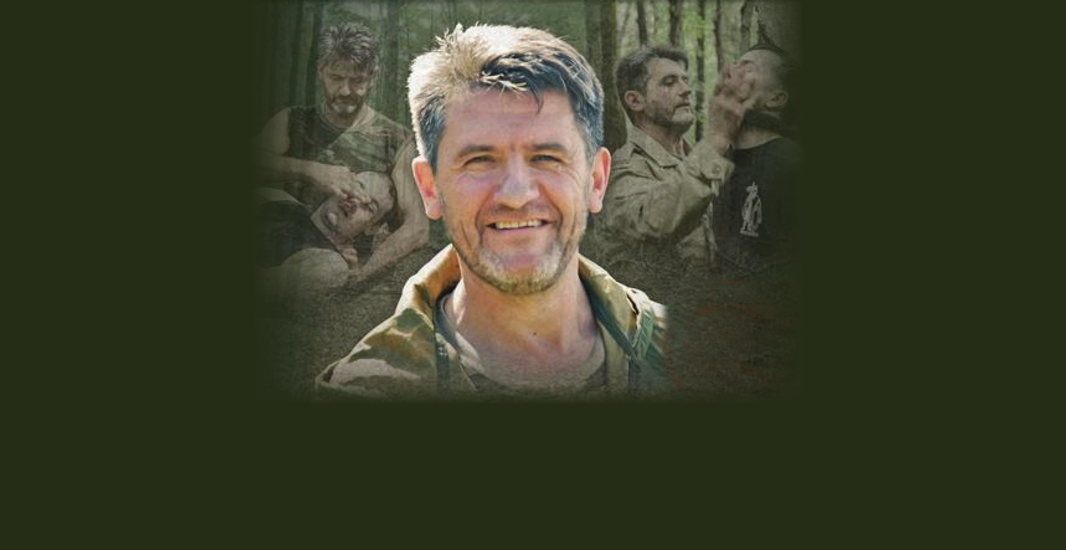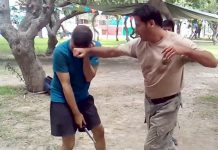 In Systema conditioning, we try to create all the exercises so that they lead us directly into the highest levels of fighting skill. Training drills are not distinct from the martial art but rather form the intensive energetic foundation for all defensive and offensive movements.
In Systema conditioning, we try to create all the exercises so that they lead us directly into the highest levels of fighting skill. Training drills are not distinct from the martial art but rather form the intensive energetic foundation for all defensive and offensive movements.
One of the variables that interferes with our effective movements in any fight is tension. I’d like to present you with some useful physical drills that help you control your tension, while you are strengthening your body and developing your breathing at the same time.
This progression can be performed as a stand-alone, independent training sequence at any time. However, it does expand on the Principles described in our training manual “LET EVERY BREATH… Secrets of the Russian Breath Masters” and the accompanying DVD “SYSTEMA BREATHING”. The key movements needed for the Tension Control sequence are described below. But if you are a beginner in Systema, please refer to the book and DVD listed above for a deeper tutorial on all aspects of Systema Breath Training: http://www.russianmartialart.com/catalog/product_info.php?cPath=23&products_id=88
Now, let’s get to this enhanced training of:
TENSION CONTROL – Upper Body
This work is another extension of ‘Relaxation and Tension Methods’ described fully in Chapter 8 of ‘LET EVERY BREATH’. We will add a new dimension, the Tension Control and perform real work (in this case, Pushups).
As many of you have read in our book, we concentrate on the 3 major muscle groups – pushups for the upper body muscles, sit-ups or leg raises for the mid section, and squats for the leg muscles. In this presentation, the Tension Control will be based on the pushup drills. We will present some new drills pertaining to the sit-ups/leg raises and squats in the Newsletters to follow.
For more detail on the posture requirements for Systema pushups, please refer to Chapter 5 of “LET EVERY BREATH” or view the “SYSTEMA BREATHING” DVD.
1. GENERAL PREPARATION
– Begin in any comfortable position lying down or sitting and exhale all residual air
– Breathe in slowly, and as you do that gradually tense up the whole body
– Stay fully inhaled just enough time to make sure every part of your body gets completely tensed up
– Breathe out slowly, and as you do that relax your whole body
– Stay fully exhaled just enough time to make sure every part of your body is completely relaxed
– Repeat this minimum 6 times or more if you like. You will see that by the 6th time your breathing will slow down and the rise and fall of tension will be more controlled
2. SPECIFIC PREPARATION
– Breathe in and gradually tense up only the muscles you will be using during pushups – your arm muscles, keep the rest of the body including your shoulders relaxed
– Breathe out and gradually relax your arms completely
– Follow the same pattern as in step 1 above and repeat at least 6 times
3. IN POSITION
– While maintaining normal steady breathing, assume the pushup position
– Inhale and tense up the entire body and arms
– Exhale and relax the entire body and arms
– Repeat only 2 or 3 times, just enough to feel your body as one united piece
This is very useful, because as soon as we anticipate an effort – unwanted tension builds up in the areas we expect to use and in the areas of our weakness. Due to these few breaths in the pushup position, our unconscious tension turns into controlled tension. At that point, we immediately become aware of our entire body and the blood flow is distributed more evenly. The key point is that you do not overwork any one part more than necessary. This protects your weaker areas, prevents injuries and results in the almost unbelievable power gain that you may have felt (and wondered about) at Systema seminars and classes.
4. LOCALIZE THE TENSION
– Inhale fairly quickly and tense up your body only, leaving the arms relaxed
– While keeping the body tense and arms relaxed, do 7 full pushups with Burst Breathing.
(Most of you know what Burst Breathing is. Just in case you do not – it is short and sharp inhales through the nose and short and sharp exhales through the mouth, with the exhaled air pushing your lips to open. You can see it clearly on “SYSTEMA BREATHING” DVD and read about it in “LET EVERY BREATH…” page 69.) This type of breathing allows you to pull pain and fatigue out of the muscles and minimizes the strain to your heart, because the oxygen supply is uninterrupted no matter how big of an effort you are exerting.
– Now, inhale again and tense up your arms only, while the rest of the body is relaxed and do 7 full pushups with Burst Breathing
– Next, tense up everything, the body and arms and do 7 pushups with Burst Breathing
– Finally, relax everything, the entire body and arms and do 7 pushups
You will be amazed at how easy it will be. People in class often say it feels as if they are flying, because now they have gained control over their tension.
5. VARIATIONS TO ENHANCE CONTROL
Instead of step 4 above try this:
– Inhale gradually and begin to tense up only the body as you lower into the pushup. The inhale-tension and the movement are to progress at the same time. Spread the inhale and build up the body tension over the full range of lowering, while the arms stay relaxed.
– Exhale slowly and rise gradually while relaxing the body, so that by the time you are all the way up you have exhaled fully, and also relaxed your body completely
– Repeat 10 times
– Inhale gradually and begin to tense up only the arms as you are going down doing a pushup.
Spread the inhale evenly with the build up of tension over the full range of lowering, keeping the arms tensed and the body relaxed
– Exhale and rise, releasing the tension from the arms the same way
– Repeat the same pattern with tensing the body and arms gradually, with breathing, on the way down and up
– Repeat each of the 3 variations 10 times
– In conclusion, do as many pushups as you like in any way you feel comfortable without any specific pattern. Watch the results…
Of course, do not forget: When you are through with this pushup-based Tension Control sequence, to balance your body with the other two core exercises – sit-ups/leg raises and squats. This will even out your blood flow, normalize your blood pressure and balance you psychologically.
When you have completed the Tension Control sequence for the Upper Body that we have we discussed in the previous Newsletter, you may proceed to the Mid-Section. The core exercises for the Mid-Section are Sit-Ups and Leg Raises. For the details on important posture requirements for these drills, please refer to Chapter 6 of “LET EVERY BREATH” or view the “SYSTEMA BREATHING” DVD.
1. GENERAL PREPARATION
– Assume a comfortable position lying down on your back and exhale all residual air
– As you have just finished working on your Upper Body, there may be some tension in the muscles involved in the pushups, so take about 6 slow deep breaths (as usual – in through the nose and out through the mouth) and check for these areas as well as for any other areas in your body that may be tense. Becoming aware of your tense/problem areas is something that should be done before any exercise, this allows you to identify, localize and later work with them.
– Breathe in, and as you do that steadily tense up the whole body
– Stay fully inhaled just enough time to make sure every part of your body gets completely tensed up
– Breathe out, and as you do that relax your whole body
– Stay fully exhaled just enough time to make sure every part of your body is completely relaxed – Repeat 2 or 3 times or more if you like. Your goal here is to cover up or dilute the small areas of tension with the big general increase of the muscle tone, to reduce the areas of discomfort and to energize the whole body.
2. SPECIFIC PREPARATION
– Breathe in and gradually tense up only the upper body, everything from the waist up, keep your lower body relaxed
– Breathe out and at the same time relax everything from the waist up completely
– Repeat 2 or 3 times
– Breathe in and gradually tense up only the lower body, everything from the waist down, keep your upper body relaxed
– Breathe out and at the same time relax everything from the waist down completely
– Repeat 2 or 3 times
For this and most other drills, we need to make our breathing independent of the muscle work, so try to alternate the breathing-tension interaction. For example, next time you practice this part of the sequence – tense up the upper body while you are exhaling and then relax on the inhale, and then repeat the same ‘reverse pattern’ with the lower body.
Refer to ‘The Principle of Breath Independence’ on page 48 of “LET EVERY BREATH”.
3. GRADUAL BUILD UP
– While maintaining the same position, keep the legs straight, begin to inhale gradually while you are tensing up the legs and lift the legs all the way up; if you can reach the floor behind your head The real challenge of this drill is to spread out the inhale and build up of tension though the entire range of the leg raise, so that the peak muscle tension happens at the point of maximum inhale.
– Exhale fully and relax the legs at the same time as the legs come back, and touch the ground at the starting point
– Repeat 7 times or more, up to 10
– Now, inhale fully and as you begin to exhale the air do the same full leg raise with gradual build up of tension
– As you inhale gradually relax the legs and return them to the original position
– Repeat 7 times or more, up to 10
– This is an extremely practical drill, it gives you an ideal way to gain control over your movements, breathing and tension. It builds endurance of your muscles and tendons as well as strengthens you psychologically, because it teaches you patience, concentration and calmness. It prevents injuries and develops sensitivity to movement and to changes within your body. Once mastered, this skill will carry over into your martial arts training and into every activity of your life.
4. LOCALIZE THE TENSION ON LEG RAISE
– Stay in the same position, inhale and tense up your body from the waist up only, while the rest of the body is relaxed and do 7 full leg raises with Burst Breathing; maintain the tension of the upper body and lift up the relaxed legs, use burst breathing to keep the movement smooth and full
– Repeat about 7 times
– Now inhale and tense up the legs only, while everything from the waist up is relaxed. Begin burst breathing, keep the legs tense and go through the full leg raise
– Repeat about 7 times
5. LOCALIZE THE TENSION ON SIT-UP
– Inhale and tense up the upper body only, while the legs are relaxed, begin burst breathing and sit-up smoothly keeping your back straight – Repeat about 7 times
– Inhale and tense up the legs only, while the upper body is relaxed, begin burst breathing and sit-up
– Repeat about 7 times
6. WORKING THOUGH COMPLETE TENSION
– Next, tense up everything, the body and legs and do 5 leg lifts with Burst Breathing and then 5 sit-ups with burst breathing
7. WORKING THOUGH COMPLETE RELAXATION
– Finally, relax everything, the entire body and legs, breathe in a normal calm and relaxed way and do 5 leg lifts and 5 sit-ups
Enjoy the results…
As many of the Systema practitioners have noticed, Steps 4, 5 and 6 of Intensifying and Localizing Tension are even more difficult to do properly than the Gradual Build Up of Tension. There are great benefits to mastering that. It develops total multitasking such as the ability to do soft and precise work with one part of your body while simultaneously executing heavy work with another part of your body. For example, gently holding a child by the hand while carrying a heavy load in the other hand – without straining yourself at all. You will also notice the ability to psychologically maintain different levels of concentration and emotional requirements at the same time.
In addition to that, please note the great benefits of Burst Breathing. We constantly get tense in our everyday life, and usually are not even aware of that, however, there is one sure sign of such tension – interrupted breathing. While you are practicing these challenging drills, you force yourself to breathe through Burst Breathing, so your breathing is never interrupted and it prevents any extra tension from accumulating. So instead of over tension you gain functional muscle tension, just enough of it to carry through your task. You become a healthy person, efficient in everything you do.
You can find related instructional material at the Systema Store
This article was published on July 31, 2007.






